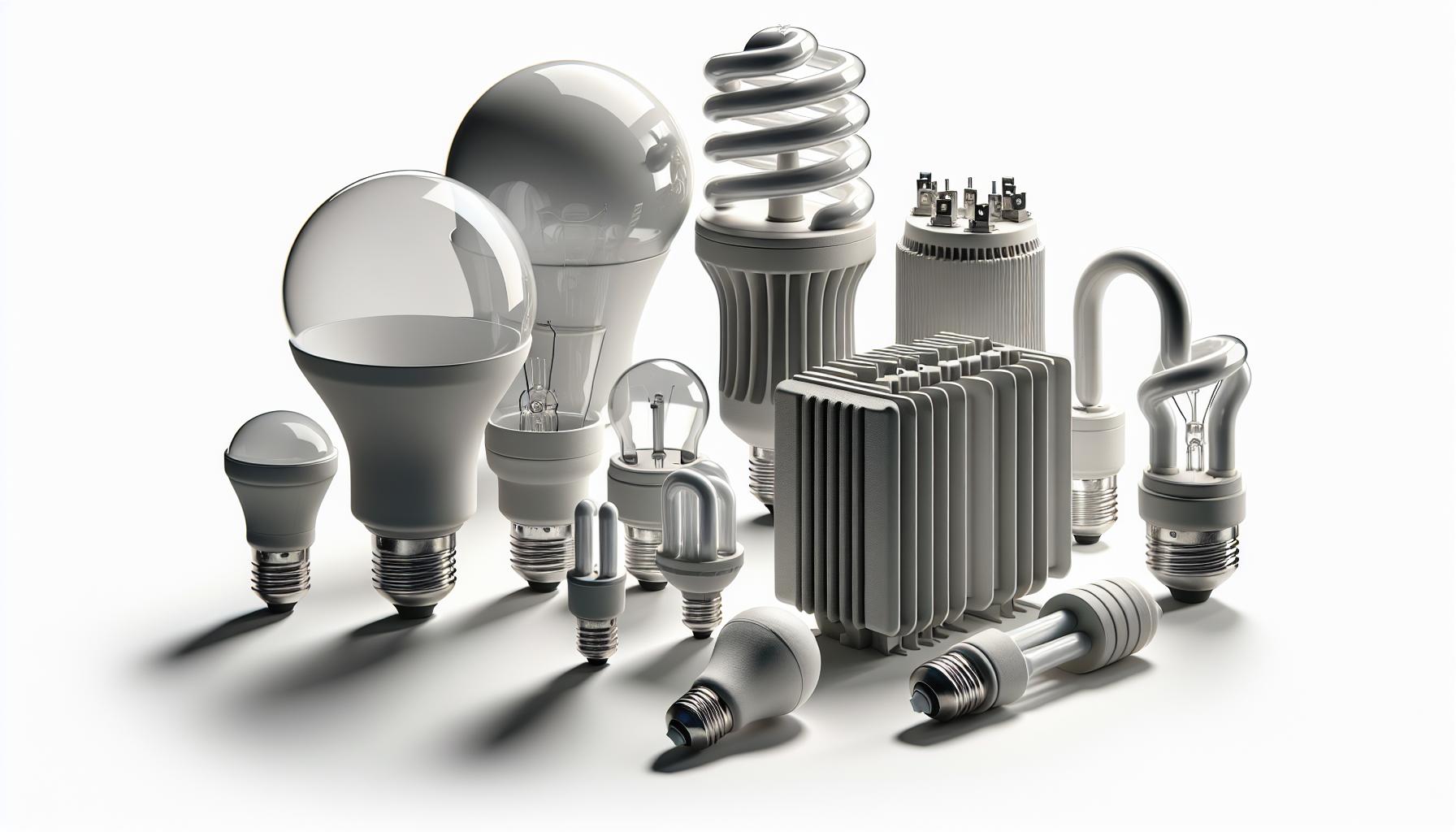Ever flicked on a light switch and heard a faint buzz or hum? It’s not just your imagination. Light bulbs can indeed make noise, and it’s a more common phenomenon than you might think. Whether it’s a soft whisper from your bedside lamp or a noticeable hum in the office, there’s science behind why these illuminating objects aren’t always silent.

You might be wondering what causes this auditory quirk. Is it something to worry about, or just a harmless side effect of modern lighting? In the next few paragraphs, we’ll shed some light on the noisy little secret of light bulbs, and what it means for your everyday life.
How Do Light Bulbs Work?
When you flick that switch, you’re completing an electrical circuit that allows current to flow. In its most basic form, a traditional incandescent bulb has a thin filament usually made of tungsten. When electricity passes through this filament, it heats up to an incredibly high temperature, causing it to glow and emit light. This process is called incandescence, and it’s the warm glow that you’ve likely grown up with.
However, the world of light bulbs has vastly expanded beyond the simple incandescent. For instance, compact fluorescent lights (CFLs) work a bit differently. These bulbs contain a gas that produces ultraviolet light when excited by electricity. This ultraviolet light then interacts with a fluorescent coating on the inside of the bulb, emitting visible light. It’s more efficient than the older style but comes with its own set of quirks, such as a brief warming up period before reaching full brightness.
Another major player in the modern lighting game is the LED bulb (Light Emitting Diode). LEDs are a game-changer in the lighting industry, thanks to their impressive lifespan and energy efficiency. They produce light when electrons move around within their semiconductor structure—a more technical process, but what’s important is the result: bright, long-lasting light with minimal heat.
You might be wondering why different bulbs make different noises. It boils down to their construction and how electricity interacts with the materials within them. Incandescent bulbs might emit a soft hum due to the vibration of the filament. In contrast, you might perceive a slight buzzing sound from CFLs as the electrical current interacts with the gas inside.
Whether you’re a home DIY enthusiast or just curious about your home fixtures, understanding how light bulbs work not only shines a light on your day-to-day life but can also help you make better choices for your lighting needs. Remember, efficient lighting not only brightens your space but can also positively impact your electricity bills and the environment.
The Science Behind Light Bulb Noise

When you flip the switch at home, you may expect just light, but sometimes you get a little buzz or hum as a bonus. You’re not alone if you’ve ever wondered why some light bulbs make noise while others don’t. There’s a bit of science behind this auditory phenomenon that’s pretty fascinating.
Incandescent bulbs, the old-school kind with a wire filament, can produce sound due to the expansion and contraction of the filament as it heats up and cools down. This can sometimes cause a faint, tiny hum. Think of it like a miniature guitar string that vibrates ever so slightly when electricity flows through it.
Moving on to CFLs, these are a bit more complex. They contain gases that produce ultraviolet light when excited by electricity. This UV light then interacts with the phosphor coating inside the bulb to create visible light. However, it’s the electrical ballast in the CFL that often causes it to hum or buzz. This device regulates the current to the bulb, but if it’s not properly insulated or it starts to age, you might begin to hear that distinctive noise.
LED bulbs are considered the quiet achievers of the bunch, but they aren’t immune to noise, either. Their noise often stems from the driver, which is necessary to convert your home’s AC power to the DC power LEDs need. A poorly designed driver might lead to an audible buzz or whine, particularly if it doesn’t match the electrical frequency it’s operating on perfectly.
Despite these noises, it’s important to remember that they’re usually not indicative of any immediate danger. However, if the sound is noticeably loud or changes suddenly, it’s wise to take a closer look or replace the bulb—better safe than sorry.
As someone who loves tinkering around with home DIY projects, you understand that attention to detail matters. Identifying the type of bulb that’s making noise and understanding the cause can help you pinpoint the issue, potentially saving you from unnecessary replacements or highlighting when it’s time for an upgrade. Remember, the lighting you choose can transform the ambiance of a space, and ensuring it operates quietly only adds to the comfort and mood you’re trying to create.
Types of Light Bulb Noise

« How Are Light Bulbs Rated? Unlocking Lumens, Efficiency, and Lifespan
Are LED Light Bulbs Good for Plants? Unlock Growth with These Tips »
As you deepen your understanding of light bulb sonics, it’s essential to recognize the variety of sounds these illuminators can emit. While some noises might be subtle and innocent, others could signal an electrical issue at play. Familiarize yourself with the common types of light bulb noise to elevate your DIY mastery to the next level.
Buzzing
Buzzing is perhaps the most common sound you’ll encounter. It generally stems from the vibration of filament or poor dimmer bulb compatibility, particularly when dealing with:
- Incandescent bulbs: A loose filament can vibrate within the bulb as electricity passes through, similar to a tiny electric guitar string.
- CFLs: The ballast may produce a humming or buzzing sound, especially if not properly matched with the light switch or dimmer.
- LEDs: In dimmable LEDs, the driver may not always communicate well with dimmer switches, leading to buzz.
Humming
You’ll notice a soft humming noise often in older fluorescent bulbs. The culprit is usually the ballast, which regulates the current flowing through the bulb. As they age, these components can begin to resonate, emitting an audible hum.
Popping
Occasionally, you may hear a pop from your bulb, which can startle but is usually not a cause for alarm. This sound is often attributed to the thermal expansion of parts within the bulb as they heat and cool during the on and off cycles.
Crackling
If you’re hearing a crackling noise, don’t ignore it. This could indicate a more serious electrical issue such as a loose connection within the light fixture or even the electrical wiring in your home. Always approach this sound with caution, opting to check the bulb and fixture connections or consulting with an electrician.
Understanding these noises ensures you’re well-equipped to address any light bulb concerns and maintain a harmoniously lit, humming-free home, all while preserving the peace of your DIY sanctuary. Keep your ears open and don’t hesitate to swap out a bulb if the symphony of sounds it produces doesn’t quite hit the right note.
Causes of Light Bulb Noise

You’ve probably noticed a few unsettling sounds coming from your light bulbs and wondered what’s behind the audio mystery. Don’t worry; you’re not alone, and understanding the causes can help you hone your DIY troubleshooting skills.
One of the most common causes of bulb noise, especially in incandescent bulbs, is a loose filament. Every time you switch on your light, electricity heats the filament till it glows. Over time, the constant heating and cooling can cause the filament to become slightly unanchored, and it begins to vibrate, hence the familiar buzzing sound.
For your compact fluorescent bulbs (CFLs), you might encounter a different scenario. These energy-savers work with ballasts to control the amount of electricity flowing through the bulb. But if your CFL’s ballast doesn’t match the specifications of the bulb – it’s lights out for silence. The mismatch creates an electrical chatter that resonates as a buzz. Watch out for these key factors:
- Wattage Differences: Bulbs and ballasts with mismatched wattages often lead to noise
- Quality Issues: Lower-quality bulbs tend to have noisier ballasts
When it comes to LED bulbs, particularly dimmable ones, the culprit is usually the driver. This component works similarly to a ballast but is tailored for LED technology. Compatibility issues between the dimmer switch and the LED driver can cause an annoying buzz. It’s essential to ensure your led dimmer switch is compatible with your bulb.
With fluorescent tubes and older fixtures, humming is a common tune. The main culprit here? An aging ballast. Just like any other piece of hardware, ballasts degrade over time, and as they do, they may create a persistent hum. Consider this a sign to planning an upgrade to a newer, quieter model.
Lastly, popping sounds might stop you in your tracks. But keep in mind, these sounds are mostly harmless and stem from the normal thermal expansion of the materials in your light bulbs. However, if you hear crackling, it’s best to take that as a red flag signaling a possible electrical issue and investigate promptly, ensuring the safety of your electrifying abode.
Remember, noises from your lights aren’t just a nuisance; they’re a conversation starter between you and your home’s electrical health. Keep your ears open and tools ready—your illuminated DIY spirit will thank you.
Can Light Bulb Noise be Harmful?

When you encounter a noisy light bulb, it’s not just an annoyance; it could potentially be a sign of an underlying hazard. While a light hum or buzz from a bulb may be benign, certain sounds can serve as a warning. It’s crucial to distinguish which noises might indicate a real threat to your safety.
Most light bulb noises aren’t harmful to your health—they’re just bothersome. Buzzing or humming often stem from minor electrical mismatches or are part-and-parcel of the bulb’s operation. However, your ears should perk up if you notice a sizzling sound or intermittent popping. These can be symptoms of a dangerous electrical issue that may not only damage your light fixture but could also pose a risk of fire if not promptly addressed.
Electrical sparks can cause a crackling sound, and they form when the electrical current jumps over gaps in the circuit, possibly because of loose wiring. If you’re hearing a crackling noise, it’s advisable to turn off the power and inspect the bulb and fixture for any signs of damage or wear.
In spaces where quiet is essential, like recording studios or home offices, even the slightest persistent noise from a light bulb can be disruptive. It’s best to opt for high-quality, noise-free lighting solutions for such environments.
Here’s what you could look for to ensure the noise from your bulbs isn’t hinting at something harmful:
- Sizzling or crackling may indicate that the bulb is at the end of its life, or there’s a more serious wiring issue.
- Flickering lights accompanied by noise is a red flag for fluctuating power and potentially poor wiring connections.
- Frequent bulb replacement in the same fixture could mean that the fixture itself is faulty, leading to possible safety concerns.
Remember, regular maintenance and inspections of your home’s electrical systems are your first line of defense against these risks. If you’re unsure or uncomfortable investigating these issues, don’t hesitate to call a professional electrician. They’re equipped to pinpoint the problem and ensure that your illuminated sanctuary remains both bright and safe.
Conclusion
You’ve got the scoop on the buzzes and hums of light bulbs. Remember, while some noise is normal, you should keep an ear out for the warnings of sizzling or crackling. Trust your instincts—if something doesn’t sound right, it’s worth a closer look. Stay safe by staying on top of your electrical maintenance and don’t hesitate to call in the pros when you need to. After all, your peace of mind is the brightest idea of all.
Frequently Asked Questions
Can light bulb noise be harmful?
Yes, certain light bulb noises can be harmful. Sizzling, popping, and crackling sounds may indicate a dangerous electrical issue that could potentially lead to a fire hazard.
What sounds should I be cautious of from a light bulb?
Be cautious of sizzling, intermittent popping, and crackling noises coming from a light bulb. These sounds can suggest severe electrical problems.
Why is quiet essential in some spaces when it comes to lighting?
In spaces where quiet is crucial, like recording studios or tranquil home environments, noise from lighting can be disruptive. Therefore, high-quality, noise-free lighting solutions are preferred.
What does sizzling or crackling from a light bulb indicate?
Sizzling or crackling noises from a light bulb may indicate that the bulb is reaching the end of its life or there’s a wiring issue.
What should I do if I’m unsure about the noise from my light bulbs?
If you’re uncertain or uncomfortable with the noise from your light bulbs, it’s crucial to get a professional electrician to inspect your home’s electrical systems. Regular maintenance and inspections are essential to ensure safety.




